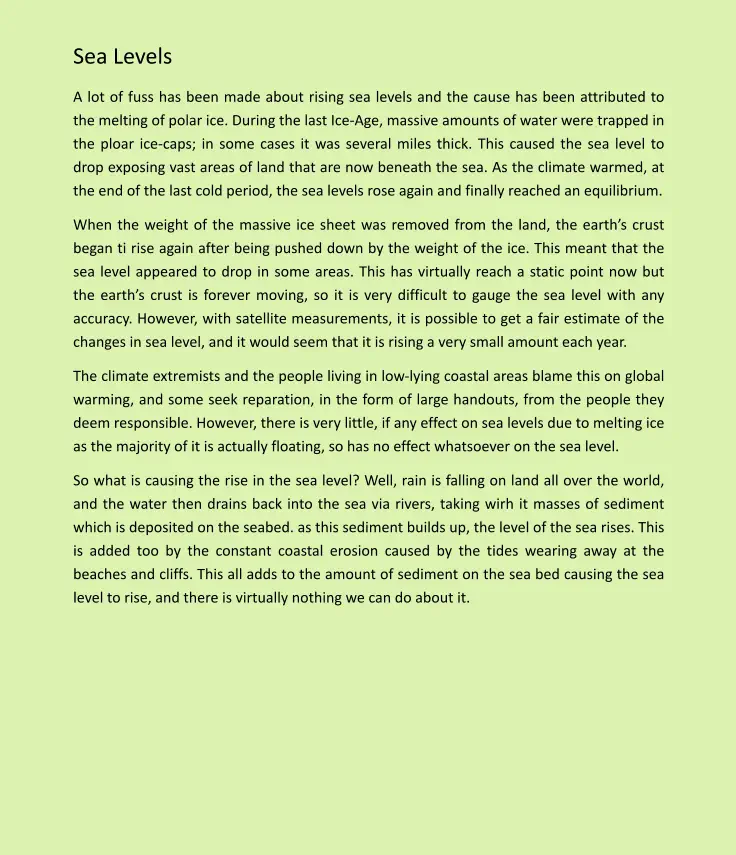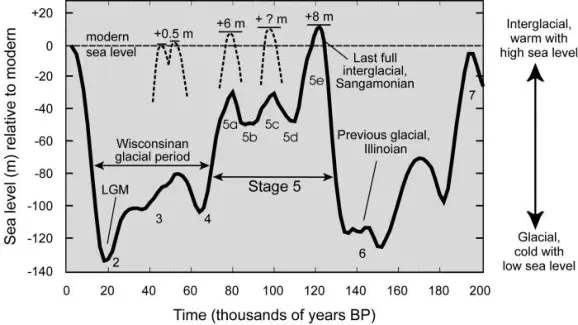Sea Levels
A
lot
of
fuss
has
been
made
about
rising
sea
levels
and
the
cause
has
been
attributed
to
the
melting
of
polar
ice.
During
the
last
Ice-Age,
massive
amounts
of
water
were
trapped
in
the
ploar
ice-caps;
in
some
cases
it
was
several
miles
thick.
This
caused
the
sea
level
to
drop
exposing
vast
areas
of
land
that
are
now
beneath
the
sea.
As
the
climate
warmed,
at
the end of the last cold period, the sea levels rose again and finally reached an equilibrium.
When
the
weight
of
the
massive
ice
sheet
was
removed
from
the
land,
the
earth’s
crust
began
ti
rise
again
after
being
pushed
down
by
the
weight
of
the
ice.
This
meant
that
the
sea
level
appeared
to
drop
in
some
areas.
This
has
virtually
reach
a
static
point
now
but
the
earth’s
crust
is
forever
moving,
so
it
is
very
difficult
to
gauge
the
sea
level
with
any
accuracy.
However,
with
satellite
measurements,
it
is
possible
to
get
a
fair
estimate
of
the
changes in sea level, and it would seem that it is rising a very small amount each year.
The
climate
extremists
and
the
people
living
in
low-lying
coastal
areas
blame
this
on
global
warming,
and
some
seek
reparation,
in
the
form
of
large
handouts,
from
the
people
they
deem
responsible.
However,
there
is
very
little,
if
any
effect
on
sea
levels
due
to
melting
ice
as the majority of it is actually floating, so has no effect whatsoever on the sea level.
So
what
is
causing
the
rise
in
the
sea
level?
Well,
rain
is
falling
on
land
all
over
the
world,
and
the
water
then
drains
back
into
the
sea
via
rivers,
taking
wirh
it
masses
of
sediment
which
is
deposited
on
the
seabed.
as
this
sediment
builds
up,
the
level
of
the
sea
rises.
This
is
added
too
by
the
constant
coastal
erosion
caused
by
the
tides
wearing
away
at
the
beaches
and
cliffs.
This
all
adds
to
the
amount
of
sediment
on
the
sea
bed
causing
the
sea
l
evel to rise, and there is virtually nothing we can do about it.
The
above
diagram
shows
the
sea
level
over
the
last
200,000
years
and
the
only
time
it
has
been
higher
than
at
the
present
time,
is
during
the
last
interglacial
when
it
was
actually
much warmer than at the present time.
Wildfires
There
have
always
been
wildfires;
they
are
a
natural
occurrence.
They
can
be
caused
by
lightning
as
well
as
by
human
activity.
Their
damage
can
be
reduced
by
good
management;
clearing
some
of
the
undergrowth,
making
firebreaks,
etc.
But
in
recent
years,
this
has
been
neglected,
encouraged
by
the
conservationalists,
who
think
it
would
disrupt
the
wildlife.
Yes,
but
not
as
much
as
a
wildfire.
Obviously,
these
fires
will
spread
more
quickly
if
the
conditions
favour
it.
A
slightly
warmer
climate
might
encourage
more
vigorous
fires,
but
it
doesn’t
mean
it’s
our
fault.
Some
of
the
worst
fires
occurred
long
before
the
climate
warmed, and the warming has only been in the order of 1 degree C.
Hurricanes
There
have
always
been
hurricanes,
but
there
is
no
evidence
of
them
getting
worse
that
they have been in the past. These are quirks of the weather and vary randomly in intensity.
Floods
Again
there
have
always
been
floods,
but
if
these
seem
to
be
increasing
in
their
effect,
it
is
more
likely
due
to
changing
conditions
of
the
rivers
and
drainage
systems.
Rivers
silt
up,
and without dredging, will be more prone to flooding.
Independent Climate Science

Disasters














